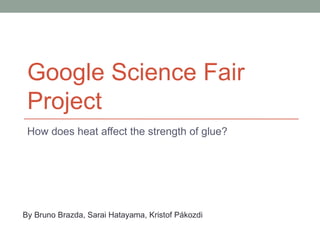How does heat affect the strength of glue
- 1. Google Science Fair Project How does heat affect the strength of glue? By Bruno Brazda, Sarai Hatayama, Kristof P├Īkozdi
- 2. Question and Hypothesis ŌĆó The question that was being answered was ŌĆ£How does heating affect the strength of glue?ŌĆØ The hypothesis was that the higher the temperature glue was made to work at, the weaker it became. To prove this, an experiment was conducted on the glue. Glues chemistry was taken into account, with its rather high viscosity. When heated, the glue becomes less viscous. This is because when heated, the particles move faster which results in more gaps between them giving the liquid better flow. When heated the hardened glue becomes a low viscosity liquid, which held less weight than the adhesive at a room temperature. This process carried itself out faster at higher temperatures.
- 3. Apparatus ŌĆó The following apparatus was set up and used in the experiment: ŌĆó Bunsen burner ŌĆó Tripod and Gauze mat ŌĆó Beaker ŌĆó String ŌĆó Weights ŌĆō 10g, 20g, 30g ŌĆó Thermometer ( degrees Celsius) ŌĆó Adhesive ŌĆó Stopwatch ŌĆó Cello tape
- 4. Set-Up Diagram Thermometer 30g weight 10ml water Bunsen Burner
- 5. Method ŌĆó Firstly, the apparatus was set up as seen in the diagram, with the Bunsen burner lit and the air hole open. ŌĆó ╠Ŗ Secondly, 10ml of water was heated to 90C and 10g weight was glued to the 30g weight which was cello taped onto the string. After waiting 10 seconds, the weight was placed 1cm from the water, being held by the string, and the stopwatch began timing. ŌĆó ╠Ŗ Next, assuring that the water remained at 90C, we waited until the weight separated from the glue and fell into the beaker. The stopwatch was then stopped and the time taken for that specific weight at that specific temperature was written down. ŌĆó Then, the Bunsen burner was removed from underneath the tripod and turned to the safety flame (closed air hole) and the beaker was let to cool down before being emptied and filled up with 10ml of water and returned to the starting position. ŌĆó Finally, these steps were repeated 9 times altogether: with 10g, 20g, ╠Ŗ ╠Ŗ ╠Ŗ 30g weights on temperatures of 90C, 100C and 110C, writing down how long each weight took to fall at each temperature.
- 6. Results
- 7. Results
- 8. Results ŌĆó After the data was analyzed, the conclusion could be drawn that the higher the temperature the glue was heated to, the less time it could hold weight for, thus the weaker it became. In total, our data consisted of 9 measurements, which had an uncertainty for temperature and time of half a Celsius and 1 second respectively. This was due to the fact that the temperature altered during the experiment, as well as the fact that there was a delay before and after we started and stopped the stopwatch because our reaction times are flawed. Altogether, the results correspond to our hypothesis. In addition, there was one measurement that stood out of the 8 other consistent ones, the 10 gram weight at 90 degrees Celsius. This measurement stands out from the rest and we think that this is because perhaps the glue had a longer amount of time to dry (over 10 seconds) which would have resulted in a longer time taken for it to give away. Therefore, if this experiment is ever repeated, extra care must be taken to assure that the glue gets attached to the weights for exactly the same time span each time.
- 9. Conclusion ŌĆó In Conclusion, using the data that had been collected, the conclusion can be drawn that the higher the temperature glue is made to work at, the weaker it becomes. We have proved our hypothesis because we have a sufficient amount of data and even though one measurement is not consistent, we can still presume that it took the longest therefore agreeing with our predictions. Furthermore, the experiment was a fair test, keeping the glue we used throughout the experiment the same, always waiting 10 seconds before exposing the glued weights to heat and always keeping 100ml of water in the beaker. These factors were vital for the data to be as reliable it is.
- 10. Bibliography ŌĆó Family Members ŌĆō ( Dr. Edgar Brazda, ) ŌĆó Educator ŌĆō Ms. Holmes, Technician Szilard ŌĆó Idea - http ://www.scienceproject.com/projects/intro/intermediate/IP112. asp ŌĆó Viscosity - http://www.spacegrant.hawaii.edu/class_acts/ ViscosityTe.html










